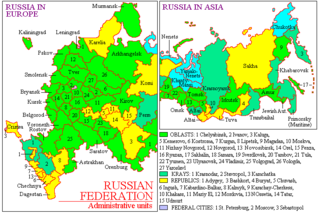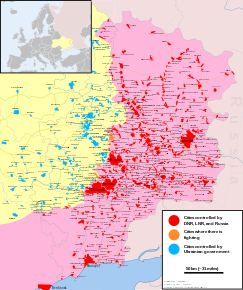External links
| This article on a play from the 1940s is a stub. You can help Wikipedia by expanding it. |
| The Russian People | |
|---|---|
| Written by | Clifford Odets Konstantin Simonov |
| Date premiered | 1942 |
| Original language | English |
| Genre | Drama |
The Russian People is a 1942 play by Clifford Odets adapted from a Russian original by Konstantin Simonov.
| This article on a play from the 1940s is a stub. You can help Wikipedia by expanding it. |

Belarus, officially the Republic of Belarus, formerly known by its Russian name Byelorussia or Belorussia, is a landlocked country in Eastern Europe bordered by Russia to the northeast, Ukraine to the south, Poland to the west, and Lithuania and Latvia to the northwest. Its capital and most populous city is Minsk. Over 40% of its 207,600 square kilometres (80,200 sq mi) is forested. Its major economic sectors are service industries and manufacturing. Until the 20th century, different states at various times controlled the lands of modern-day Belarus, including the Principality of Polotsk, the Grand Duchy of Lithuania, the Polish–Lithuanian Commonwealth, and the Russian Empire.

Chechnya, officially the Chechen Republic, is a federal subject of Russia.
The Mongols are a Mongolic ethnic group native to Mongolia and to China's Inner Mongolia Autonomous Region. They also live as minorities in other regions of China, as well as in Russia. Mongolian people belonging to the Buryat and Kalmyk subgroups live predominantly in the Russian federal subjects of Buryatia and Kalmykia.

Russia, or the Russian Federation, is a European country located in Eastern Europe with a vast expanse of territory that stretches across Northern Asia. At 17,125,200 square kilometres (6,612,100 sq mi), it is by far the largest country in the world by area, covering more than one-eighth of the Earth's inhabited land area, spanning eleven time zones, and bordering 16 sovereign nations. The territory of Russia extends from the Baltic Sea in the west to the Pacific Ocean in the east, and from the Arctic Ocean in the north to the Black Sea and the Caucasus in the south. With 146.7 million inhabitants living in the country's 85 federal subjects as of 2020, Russia is the most populous nation in Europe and the ninth-most populous nation in the world. Russia's capital and largest city is Moscow; other major urban areas include Saint Petersburg, Novosibirsk, Yekaterinburg, Nizhny Novgorod, Kazan and Chelyabinsk.
Russian refers to anything related to Russia, including:

Russian is an East Slavic language, which is an official language in Russia, Belarus, Kazakhstan and Kyrgyzstan, as well as being widely used throughout Eastern Europe, the Baltic states, the Caucasus and Central Asia. It was the de facto language of the Soviet Union until its dissolution on 25 December 1991. Although nearly three decades have passed since the breakup of the Soviet Union, Russian is used in official capacity or in public life in all the post-Soviet nation-states, as well as in Israel and Mongolia.

The Russian Revolution was a period of political and social revolution across the territory of the Russian Empire, commencing with the abolition of the monarchy in 1917, and concluding in 1923 after the Bolshevik establishment of the Soviet Union, including national states of Ukraine, Azebaijan and others, and end of the Civil War.

The Russian Civil War was a multi-party civil war in the former Russian Empire immediately after the two Russian Revolutions of 1917, as many factions vied to determine Russia's political future. The two largest combatant groups were the Red Army, fighting for the Bolshevik form of socialism led by Vladimir Lenin, and the loosely allied forces known as the White Army, which included diverse interests favouring political monarchism, capitalism and alternative forms of socialism, each with democratic and anti-democratic variants. In addition, rival militant socialists and non-ideological Green armies fought against both the Bolsheviks and the Whites. Eight foreign nations intervened against the Red Army, notably the former Allied military forces from the World War and the pro-German armies.

The Soviet Union, officially known as the Union of Soviet Socialist Republics, was a federal sovereign state in northern Eurasia that existed from 1922 to 1991. Nominally a union of multiple national Soviet republics, in practice its government and economy were highly centralized. The country was a one-party state, governed by the Communist Party with Moscow as its capital in its largest republic, the Russian Soviet Federative Socialist Republic. Other major urban centers were Leningrad, Kiev, Minsk, Tashkent, Alma-Ata, and Novosibirsk. It spanned over 10,000 kilometers (6,200 mi) east to west across 11 time zones, and over 7,200 kilometers (4,500 mi) north to south. Its territory included much of Eastern Europe, as well as part of Northern Europe and all of Northern and Central Asia. It had five climate zones: tundra, taiga, steppes, desert and mountains.

Siberia is an extensive geographical region spanning much of Eurasia and North Asia. Siberia has been part of modern Russia since the 17th century.

Tajikistan, officially the Republic of Tajikistan is a mountainous, landlocked country in Central Asia with an area of 143,100 km2 (55,300 sq mi) and an estimated population of 9,275,828 people. It is bordered by Afghanistan to the south, Uzbekistan to the west, Kyrgyzstan to the north, and China to the east. The traditional homelands of the Tajik people include present-day Tajikistan as well as parts of Afghanistan and Uzbekistan.

Vladimir Vladimirovich Putin is a Russian politician who has served as the president of Russia since 2012, previously holding the position from 2000 until 2008. He was also the Prime Minister of Russia from 1999 to 2000 and again from 2008 to 2012.
The Tatars are a Turkic ethnic group living mainly in Tatarstan and the wider Volga-Ural region. They speak Tatar, a Kipchak Turkic language. The vast majority of Tatars today reside in post-Soviet countries, primarily in Russia, Ukraine and Uzbekistan. The vast majority of Tatars are Muslims.

Russians are an East Slavic ethnic group native to European Russia and other parts of Eastern Europe ; they are the most numerous ethnic group in Europe. The majority of ethnic Russians live in the Russian Federation, but notable minorities exist in other former Soviet states such as Belarus, Kazakhstan, Moldova, Ukraine and the Baltic states. A large Russian diaspora has developed all over the world, with notable numbers in the United States, Germany, Brazil, and Canada. The culture of the ethnic Russian people has a long tradition and it is a foundation for the modern culture of the whole of Russia. The Russian language originally was the language of ethnic Russians. They are historically Orthodox Christians by religion.

The Volga is the longest river in Europe with a catchment area of 1,350,000 square kilometres. It is also Europe's largest river in terms of discharge and drainage basin. The river flows through central Russia and into the Caspian Sea, and is widely regarded as the national river of Russia, being an important river for mainly Slavic, Turkic people, Iranian cultures such as Scythians and Sarmatians, Finno-Ugric and Germanic people, Greeks and cultures of Byzantine and Sasanian Empires. Due to its geographical situation the Volga played an important role in the movement of people between east and west as well as south and north. The river flows in Russia through forests, forest-steppes and steppes.

Alaska Natives or Alaskan Natives are indigenous peoples of Alaska, United States and include: Iñupiat, Yupik, Aleut, Eyak, Tlingit, Haida, Tsimshian, and a number of Northern Athabaskan cultures. They are often defined by their language groups. Many Alaska Natives are enrolled in federally recognized Alaska Native tribal entities, who in turn belong to 13 Alaska Native Regional Corporations, who administer land and financial claims.

Dagestan, officially the Republic of Dagestan, is a federal subject of Russia, located in the North Caucasus region. Its capital and largest city is Makhachkala, centrally located on the Caspian Sea coast.

European Russia is the western part of the Russian Federation, which is located in Eastern Europe. It covers up to 39% of Europe's total land area. Although European Russia covers less than 25% of Russia's territory, it has a population of 110 million people, housing 77% of Russia's population, making Russia the most populous European nation. European Russia includes Moscow and Saint Petersburg, the two largest cities in Russia.

The Russian Soviet Federative Socialist Republic, previously known as the Russian Soviet Republic and the Russian Socialist Federative Soviet Republic, as well as being unofficially known as the Russian Federation, Soviet Russia, or simply Russia, was an independent state from 1917 to 1922, and afterwards the largest and most populous of the Soviet socialist republics of the Soviet Union (USSR) from 1922 to 1990, until becoming a sovereign part of the Soviet Union with priority of Russian laws over Union-level legislation in 1990 and 1991, the last two years of the existence of the USSR. The Russian Republic was composed of sixteen smaller constituent units of autonomous republics, five autonomous oblasts, ten autonomous okrugs, six krais and forty oblasts. Russians formed the largest ethnic group. The capital of the Russian SFSR was Moscow and the other major urban centers included Leningrad, Novosibirsk, Yekaterinburg, Nizhny Novgorod and Samara.

The War in Donbass is an armed conflict in the Donbass region of Ukraine. In the aftermath of the Euromaidan movement and the 2014 Ukrainian revolution, protests against the newly formed government took place in the Donetsk and Luhansk oblasts of Ukraine, an area commonly collectively called the "Donbass". These demonstrations were part of a wider group of concurrent pro-Russian protests across southern and eastern Ukraine. The protests in Donbas escalated into an armed conflict between the separatist forces of the self-declared Donetsk and Luhansk People's Republics, and the Ukrainian government. In the Donetsk People's Republic, from May 2014 until August 2014 some of the top leaders were Russian citizens. According to the Ukrainian government, at the height of the conflict in mid-2014, Russian paramilitaries were reported to make up between 15% to 80% of the combatants.